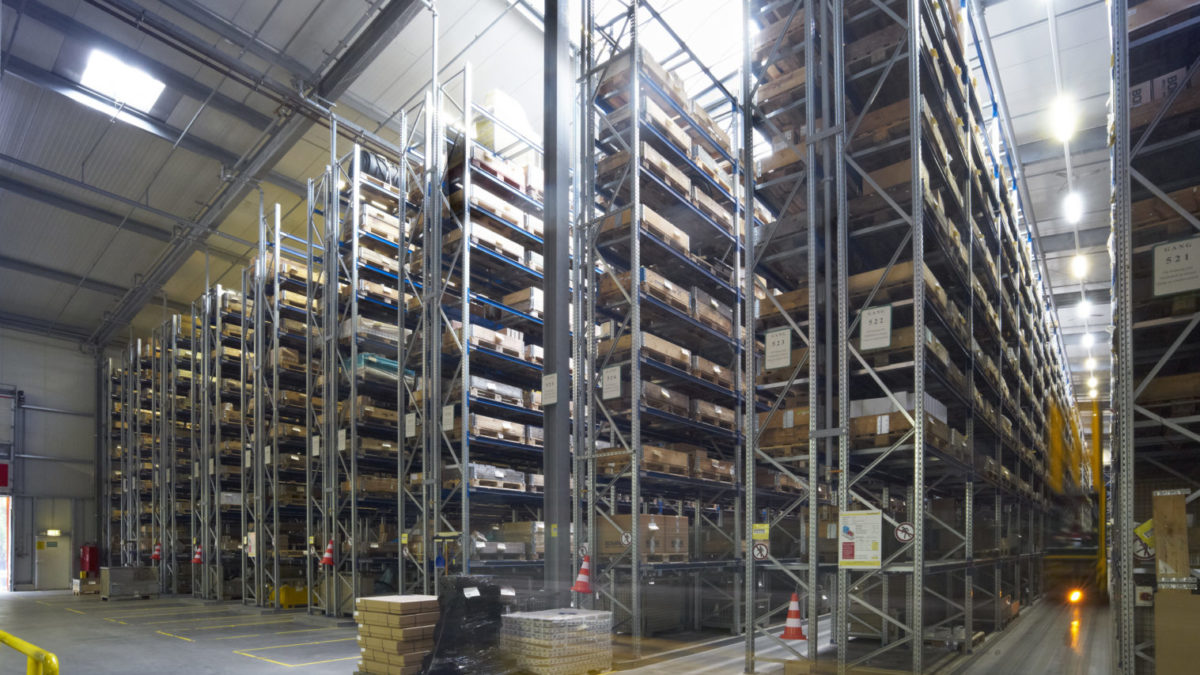
Flow rack
22. February 2024
Transshipment
22. February 2024The world as we know it is kept running by a complex and finely tuned network of logistics centers. From the simple delivery of a parcel to the distribution of vital goods in times of crisis, logistics centers play a crucial role in our globalized economy. They are the invisible backbone that enables the smooth flow of goods and services, ensuring that businesses function efficiently and customers are satisfied.
Logistics centers are far more than just huge warehouses. They are highly dynamic, technology-driven facilities that perform a variety of functions, from storage and inventory management to order fulfillment, shipping and delivery. They are the interface between producers and consumers, between supply and demand.
In this blog post, we will dive deeper into the world of logistics centers. We will look at their functions and types, how they are organized, what technologies they use and what challenges they face. Whether you’re a business professional looking for optimization opportunities, a curious consumer who wants to understand how their online order gets to them, or someone looking to pursue a career in the logistics industry, this article will give you a comprehensive look at the heart of modern logistics.
The most important points at a glance
A logistics center consists of several areas, including the receiving area, storage area, picking area, packing and shipping area and office areas.
Efficiency and optimization are critical to the design and operation of a logistics center, as they help to speed up the movement of goods, improve workflows and reduce costs.
Technology is playing an increasingly important role in logistics centers, including automation, artificial intelligence, IoT, digital twins and blockchain.
Logistics centers face challenges such as capacity issues, safety concerns, environmental impact and skills shortages. Solutions include automating processes, using digital tools, sustainable practices and investing in people.
What is a logistics center?
A logistics center, often referred to as a distribution center, is a purpose-built facility designed to store, manage and distribute goods. It is a central hub in the supply chain where goods are received from suppliers, carefully cataloged and stored before being shipped as needed to retail stores, wholesalers or directly to consumers.
The primary function of a logistics center is to maximize the efficiency of goods distribution. This is achieved through a combination of warehouse, transportation and information management. A well-managed logistics center can help shorten delivery times, reduce costs and improve customer service.
It is important to distinguish between a logistics center and a simple warehouse. A warehouse is essentially a place to store goods. It can provide minimal services such as unloading goods and basic inventory management, but does not have the extensive capabilities of a logistics center.
A logistics center, on the other hand, offers a variety of services that go beyond mere storage. These include order processing, packaging and labeling of goods, management of returns, quality control and even customer-specific services such as assembling products or providing after-sales services.
In this sense, a logistics center is not just a physical location, but an integral part of a company’s operational management and strategic planning. It plays a crucial role in optimizing operational efficiency and customer satisfaction.
Functions of a logistics center
A logistics center offers a variety of functions and services that go far beyond the mere storage of goods. Here are the main functions that a typical logistics center performs:
1. receiving and quality control
One of the first steps in the logistics center is goods receiving. This is where goods are received from suppliers or producers, inspected and registered. Quality control plays a crucial role in this process. Each item is checked for damage and its quality is assessed to ensure that only products that meet the standards are included in the inventory.
2. storage and inventory management
Once the goods have been received and checked, they are stored. The logistics center is responsible for storing the goods safely and efficiently to allow quick and smooth access. This also includes inventory management, which ensures that there is an accurate overview of the goods available and their locations at all times.
3. picking and packing
Picking refers to the process by which specific items are selected from stock and prepared for dispatch. This is usually done on the basis of customer orders. After picking, the items are properly packaged to protect them for transportation.
4. shipping and delivery
The logistics center is also responsible for shipping the prepared goods to customers or retail stores. This includes planning and coordinating deliveries to ensure that the goods reach the recipient on time and in good condition.
The different types of logistics centers
There are different types of logistics centers, each designed for different functions within the supply chain. Here are some of the most common types:
1. distribution centers
Distribution centers serve as a central hub where goods are received from various suppliers and then distributed to various retail locations. They are usually large and hold a large amount of inventory to meet continuous demand.
Pros: They offer efficiency in terms of storage and transportation as they can handle large quantities of goods and ship them to many different locations.
Cons: They can be costly, both to operate and to set up, and require a lot of space.
2. fulfillment centers
Fulfillment centers are specifically designed to process online orders. They receive goods from suppliers, store them and then pack individual orders for direct shipment to customers.
Advantages: They enable fast delivery times and a high degree of flexibility as they are able to process individual customer orders.
Cons: They can be complex and expensive to operate as they have to manage a high number of SKUs (Stock Keeping Units) and process a large number of individual orders.
3. cross-dock facilities
Cross-docking is a process where inbound goods are prepared for outbound almost immediately, without the need for long-term storage. Cross-dock facilities are designed to support this process efficiently.
Pros: They minimize storage costs and shorten delivery times as goods are moved quickly through the facility.
Cons: They require precise planning and coordination as goods need to be turned over quickly, and they offer little flexibility in case of delays or changes in demand.
Each type of logistics center has its own advantages and disadvantages and specializes in certain aspects of the supply chain. Choosing the right type depends on many factors, including the type of goods being handled, the specific requirements of customers and the overall structure of the supply chain.
General structure and organization of a logistics center
A logistics center is usually divided into different areas, each of which performs specific functions. Here is an example of a typical layout:
Incoming goods area: this is where goods arrive from suppliers. They are inspected, registered and then transported to the storage area.
- Storage area: This area is usually the heart of the logistics center. It is usually divided into different zones to store different types of goods. This is where inventory management is carried out.
- Picking area: This is where goods are selected from the warehouse based on customer orders and prepared for shipment.
- Packing and shipping area: After selection, the goods are packed and labeled. They are then prepared for transportation to the customer or retail store.
- Office areas: These areas house the administrative staff who are responsible for tasks such as order management, customer service and general administration of the logistics center.
Importance of efficiency and optimization in logistics center design
Efficiency and optimization are critical to the design and operation of a logistics center. An efficient layout can help speed up the movement of goods, improve workflows and reduce costs.
Some aspects to consider when optimizing a logistics center include the placement of storage zones to minimize the distance goods must travel through the center, or the use of technologies such as automated storage and picking systems to increase efficiency.
In addition, optimization can also include strategic workforce planning, improving processes and implementing quality control systems.
Technology in logistics centers
The role of technology in logistics centers has increased significantly in recent years. It enables greater efficiency, improved accuracy and increased speed in handling warehouse and shipping tasks. Here are some examples of technologies used in modern logistics centers:
- Automation: automated systems can take over many manual tasks, from storing and picking goods to packing and shipping. For example, companies like Amazon use robots to move and sort goods in their fulfillment centers.
- Artificial intelligence and machine learning: These technologies can help to recognize patterns in data, make predictions and make decisions. For example, they can be used to predict demand for certain products or determine the most efficient ways to pick and deliver goods.
- Internet of Things (IoT): IoT devices can collect and transmit data in real time, enabling better monitoring and control of inventory and supply chains.
- Digital twins and virtual reality: Digital twins are virtual models of physical objects or systems. They can be used in logistics centers to simulate and optimize processes. Virtual reality can be used to train employees or to visualize data and processes.
- Blockchain technology: Although it is not yet widely used, blockchain technology has the potential to improve transparency and traceability in the supply chain.
Challenges and solutions of logistics centers
Logistics centers face a number of challenges, ranging from capacity issues to security concerns and environmental impacts. Here are some of the most common challenges and possible solutions:
Capacity issues: As online commerce increases, so does the pressure on warehouse and logistics center infrastructure. The global pandemic has further increased the volume of e-commerce orders and thus the strain on logistics centers.
Solution: One way to overcome this challenge is to automate processes to increase efficiency and process more orders in less time.
Safety concerns: The safety of quality products during transportation and storage is another major challenge.
Solution approach: Digital tools and technologies such as tracking and monitoring systems can help improve security and minimize the risk of theft or damage.
Environmental impact: The logistics industry faces the challenge of finding environmentally friendly solutions without compromising efficiency and profitability.
Solution: Sustainable practices such as optimizing transport routes to reduce CO2 emissions, using renewable energy and implementing recycling programs can help.
Skills shortage: The lack of skilled labor is another challenge, especially during peak seasons.
Solution: Investing in education and training, attractive working conditions and flexible working hours can help to attract and retain skilled workers.
Final thoughts and prospects for the future
The future of logistics centers likely lies in further integration of technology and automation. This will not only help to overcome some of the current challenges, but also create new opportunities for efficiency and optimization.
In addition, sustainability is likely to play an increasingly important role as companies are under pressure to reduce their environmental impact. This could encourage innovation in areas such as energy efficiency, waste management and green logistics.
Finally, the importance of a skilled workforce will remain high despite automation. Training and upskilling employees in new technologies and processes will therefore be crucial.
Overall, logistics centers face an exciting future full of challenges and opportunities.

